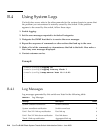
Appendix B Troubleshooting B-3
■ Check that you have a valid network connection to the switch and that the port
you are using has not been disabled. See “Port Configuration” on page 3-96.
■ If there are only Layer 2 switches between the management station and system
chassis, make sure that:
■ The switch’s management VLAN is configured with a valid IP address and
subnet mask.
■ The management station has an IP address in the same subnet as the
management VLAN.
■ The management station is connected to a switch port that is a member of the
management VLAN.
■ The ports connecting intermediate switches in the network are tagged ports
and are a member of the management VLAN.
■ If there are one or more Layer 3 switches between the management station and
system chassis, make sure that:
■ The switch’s management VLAN is configured with a valid IP address, subnet
mask, and default gateway.
■ The management station has valid IP address, subnet mask, and default
gateway.
■ The management station is connected to a switch port that is a member of the
management VLAN.
■ The ports connecting intermediate switches and the Layer 3 switch(es) in the
network are tagged ports and are a member of the management VLAN.
■ If you cannot connect using Telnet, you may have exceeded the maximum
number of concurrent Telnet sessions permitted. Try connecting again at a later
time.
If you cannot access the command-line interface through a serial port connection,
check the following:
■ Use the DB-9-to-RJ-45 cable supplied with the Sun Fire B1600 blade system
chassis to connect your terminal or computer to the serial port on the SSC
module.
■ Be sure you have set the terminal emulator program to VT100 compatible, 8 data
bits, 1 stop bit, no parity and 9600 bps.


















